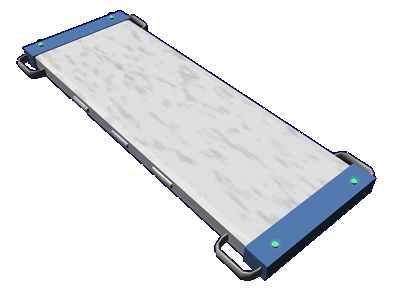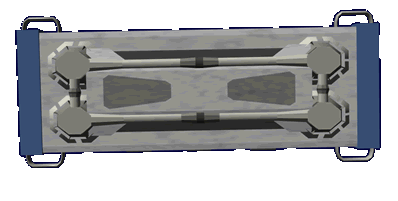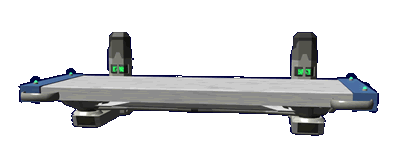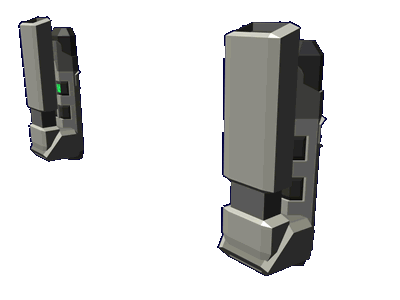Table of Contents
Ke-T8-M3201 Grav Gurney
Ke-T8-M3201 Grav Gurney was developed for use with the Kuma T8 Medevac Shuttle in YE 32
About
The Grav Gurney is a stretcher and a Gurney in one. Its original purpose was to transport patients on and off of the Kuma T8 Medevac Shuttle, but the Gurney has found a niche in most EMS areas. The Grav Gurney can be safely operated by one person.
History
The Grav Gurney came about as a better way of moving injured personnel over treacherous terrain. Originally the concept was to make the Gurneys autonomous able to return back to the Kuma T8 Medevac Shuttle. However, this would have required adding significantly to cost and complexity. So the designers opted for a system that assisted the people carrying the gurney instead.
Using the Grav Gurney
The Grav Gurney is very simple to operate. Grabbing one of the handles causes it to detach from the Ke-T8-M3202 Docking Station. The gurney has motion sensors built into it and provides motive assist in the direction of movement. The motive assist cuts off if the gurney senses resistance to movement, such as the operator pulling back, or hitting an object. The Gurney will automatically keep itself level unless the operators press the override switch on any of the handles. If the people holding the gurney release the handles while it has a patient on it, the gurney will stop and remain in hover mode.
Double-clicking any of the handle switches signals the gurney to go into standby.
General
Class: Ke-T8-M3201 Type: Personal Gear Designers: Ketsurui Fleet Yards Manufacturer: Ketsurui Fleet Yards, Scientific Studies Service, Geshrinari Shipyards Production: Mass Production
Dimensions
Length: 2.13 meters (7 feet) Height: 20.32cm (8in) Width: 76.2cm (30in)
Performance
Capacity: The Gurney is capable of lifting up to 113kg or 250lbs on its own. If the patient and any life saving equipment with them on the gurney exceeds this, the operators have to provide the additional lift.
Note: If the Gurney is loaded beyond its capacity and the operators release it, it will drop quickly towards the ground, but slower than it would if the gurney had no lift system.
Systems
Grav Modules
The Grav Gurney uses four anti-grav modules to lift and stabilize.
Power Cell
The Grav Gurney has four rechargeable power cells that provide up to four hours of continuous operation.
Motive Control
Under the Gurney surface is the Motive Control assembly. This contains the power cells, accelerometers, and control circuits. All four of the handles have a thumb activated kill-switch. When any of the switches is pressed the Motive Assist feature will engage. If all four are released the unit will go into hover mode. Double clicking one of the switches turns the Gurney to standby mode.
Ke-T8-M3202 Docking Station
Grav Gurney docking station. It consists of a pair of raising arms that hold the Grav Gurney secure and recharges the power cells in Grav Gurney. The docking station is mounted on the wall of the vehicle or facility it it belongs to and requires a dedicated power line.
When the Grav Gurney is lifted away from the Docking Station, the arms of the station stay in place for fifteen seconds. After which time the arms swing up into the stowed position and the station goes into standby. Pulling on one of the arms causes the station to become active and both arms swing down to accept a gurney.



